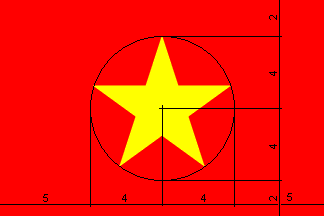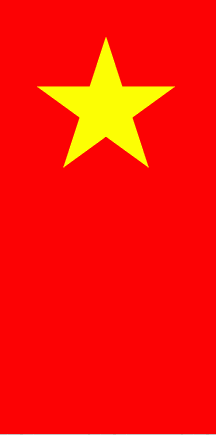
This page is part of © FOTW Flags Of The World website
Viet Nam
Socialist Republic of Viet Nam
Last modified: 2019-04-22 by randy young
Keywords: viet nam | asia | francophonie | star: 5-point | communist party | vietnam |
Links: FOTW homepage |
search |
disclaimer and copyright |
write us |
mirrors

image by Zachary Harden, 5 March 2017
Proportions: 2:3
Usage Code: 
Construction Sheet

image by Željko Heimer
Local Name: Cộng Hòa Xã Hội Chủ Nghĩa Việt
ISO Code: VN VNM 704
FIPS 10-4 Code: VM
MARC Code: vm
IOC Code: VIE
See also:
Other sites:
- Flags of Vietnam: New Discoveries (This Vietnamese website published this page, reproduced from Francia Vexilla, containing scans from a long document in French which cites several other vexillological resources and contains numerous flag images. The flags described include national, sub-national, ethnic and religious flags, starting from pre-colonial era and until the end of Vietnam War.)
The five points of the star stand for the farmers, workers, intellectuals, youth and soldiers. Adopted 1955 (modified from 1945 flag). (Jos Poels, Prisma vlaggenboek, 1990)
Mark Sensen, 19 September 1997
I did not see any reference to the date on which they turned on the actual pattern. Well, here it is: the current flag of Viet Nam was officially put into use by the then North Viet Nam on 30 November 1955.
Pier Paolo Lugli, 10 October 1997
The adoption date given on FOTW is 30 September 1955. On the other hand, Smith [smi82] gives date of "official hoisting 2 July 1976." This is explained, I guess so - the 1955 was adoption of the flag by Democratic Republic of Viet Nam (i.e. North Viet Nam), while in 1976 it was adopted by the united Socialist Republic of Viet Nam.
Željko Heimer, 7 September 2003
New Zealand's Prime Minister Helen Clark has just completed a brief state visit to Vietnam, prior to the APEC meeting in Thailand.
News footage here showed a motorcade with cars flying small NZ and Vietnamese flags. The Vietnamese flag definitely had the gold star displaced towards the hoist, I'd say about 2/5 of the way from hoist to fly, rather than centred as in the usual national flag.
James Dignan, 19 October 2003
The protocol manual for the London 2012 Olympics (Flags and Anthems Manual London 2012) provides recommendations for national flag designs. Each NOC was sent an image of the flag, including the PMS shades, for their approval by LOCOG. Once this was obtained, LOCOG produced a 60 x 90 cm version of the flag for further approval. So, while these specs may not be the official, government, version of each flag, they are certainly what the NOC believed the flag to be.
For Vietnam: PMS 186 red, 116 yellow. The vertical flag is simply the horizontal version turned 90 degrees clockwise.
Ian Sumner, 11 October 2012
Tonight, a user at Wikipedia pointed to specifications regarding the national flag of Viet Nam. On 10 October 2012, a guide (Huong dan, HD) was issued by the Ministry of Culture, Sports and Tourism (BVHTTDL) regarding not only the use of the national flag but also specifications for the size and placement of the star. According to the Guide, which can be read in Vietnamese at http://bvhttdl.gov.vn/vn/vb-qly-nn/1/1195/index.html, shows the star is centered on a flag that has a width to length ratio of 2x3. The star center to the top point has a radius of 1/5th of the length of the flag. A photo diagram, issued by the City of Da Nang at http://www.baodanang.vn/dataimages/201608/original/images1289003_Treo_co_1.jpg, shows the construction of the star on the flag.
Zachary Harden, 5 March 2017
Well found. This actually repeats decision (decree) No. 578 KHKY/QD on the "National Flag of the Socialist Republic of Vietnam" dated 30 December 1977 (effective 1 July 1978). You are quite properly correcting the construction details we have on FOTW – details which I should have noticed we had wrong. We show the star as being contained within a circle 2/3rds of flag width high, whereas the correct size of that circle is (as Zachary pointed out) 3/5ths - in other words 2-6-2 for the hoist and 15 for the fly.
Chris Southworth, 6 March 2017
.gif)
image located by Esteban Rivera, 15 April 2006
Source: Wikipedia
The legislation of Viet Nam is available searchable on line at http://vbqppl.moj.gov.vn/vbpq/Pages/search.aspx in Vietnamese, but parts are also provided in English at http://vbqppl.moj.gov.vn/vbpq/en/pages/vbpq.aspx. Several flag related decisions and decrees may be found in the English part by searching for the keyword flag, from which I copy:
Decree 10/2005/ND-CP 31/01/2005
http://vbqppl.moj.gov.vn/vbpq/en/Lists/Vn%20bn%20php%20lut/View_Detail.aspx?ItemID=7109
Providing for the customs sector's flag, pennant, symbol, emblem, insignia, badges, uniforms, and identity card
Published Date: 31 January 2005
Validated Date: 1 March 2005
(the English text provides only a dull summary)
Decision 12/2005/QD-BQP 12/01/2005
http://vbqppl.moj.gov.vn/vbpq/en/Lists/Vn%20bn%20php%20lut/View_Detail.aspx?ItemID=7160
Prescribing badges of defense army personnel, public employees and workers, and national flags on commanders' working tables
Published Date: 12/01/2005
Validated Date: 15 February 2005
(the English text provides only a dull summary)
Decree 154/2004/ND-CP 09/08/2004
http://vbqppl.moj.gov.vn/vbpq/en/Lists/Vn%20bn%20php%20lut/View_Detail.aspx?ItemID=7758
On the State's rituals in organizing meetings and cerebrations; awarding and receiving the State's honorable titles, orders, medals, the Government's emulation flags, and the Prime Minister's diplomas of merit
Published Date: 9 August 2004
Validated Date: 6 September 2004
(the English text provides only a dull summary)< BR>
Decree 18/2000/ND-CP 29/05/2000
http://vbqppl.moj.gov.vn/vbpq/en/Lists/Vn%20bn%20php%20lut/View_Detail.aspx?ItemID=429
Stipulating Viet Nam's customs service flag, emblem, insignia, badges, symbol, pennant and uniform
Published Date: 29 May 2000
Validated Date: 29 May 2000
(the English text provides only a slightly longer summary from which is: Viet Nam's customs traditional banner is used in meetings to mark anniversaries and traditional days, receptions of the State's and the Party's noble awards and other important activities of the customs service. The customs' symbol is used for pinning on pennant, service flag and printed on a number of papers, forms, working facilities or souvenirs,... of Viet Nam Customs. Viet Nam's customs pennant is pinned on patrol and control means of Viet Nam Customs. The customs emblem is pinned on kepi. The customs insignia is pinned on lapel. Viet Nam's customs emblem, rank badges, insignia, pennant and uniform are made for exclusive use by customs officials and employees on duty according to regulations.)
Decree 86/1998/ND-CP 24/10/1998
http://vbqppl.moj.gov.vn/vbpq/en/Lists/Vn%20bn%20php%20lut/View_Detail.aspx?ItemID=1322
Stipulating the People's Police service flag, emblem, rank badges, insignia and uniform
Published Date: 24 October 1998
Validated Date: 8 November 1998
(the English text provides only a dull summary)
Decree 78/CP 18/06/1997
http://vbqppl.moj.gov.vn/vbpq/en/Lists/Vn%20bn%20php%20lut/View_Detail.aspx?ItemID=2435
DETERMINING THE MILITARY SIGNALS, INSIGNIAS, FULL-DRESS UNIFORM, MILITARY FLAG, SECURITY CHECK BADGES, DUTY PLATES, PENNANTS AND IDENTITY CARDS OF THE BORDER GUARDS
Published Date: 18 June 1997
Validated Date: 1 July 1997
(the English text provides a full translation including:
Article 3.- The military flag of the Border Guards is the military flag of the Vietnam People's Army. The military flag of each rank of the Border Guards shall be determined by the Minister of Defense.
... and then in the Art. 4 under Section 3:
3. Pennants shall include the patrol pennant and urgency pennant. a/ The border patrol pennant is green, in right-angled triangle shape with the symbol of the military signal inside and the inscription below the signal: "TUAN TRA BIEN PHONG" (Border Patrol), mounted on front of the vehicle being on duty. b/ The urgency pennant is green, in isosceles triangle shape with yellow fringes at the two sides, the symbol of the military signal and the yellow arrow in the middle, mounted on front of the vehicle being on urgent duty."
Željko Heimer, 18 February 2012

image by Klaus-Michael Schneider, 13 May 2010
The ratio is approx 2:1, the star’s centre is more or less at the bottom of the first quarter from above.
Source: based upon a photo, shot by Christian Timm in Long Hai on 31 January 2009
Klaus-Michael Schneider, 13 May 2010



.gif)
